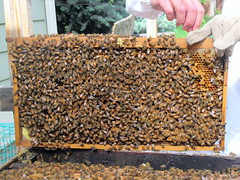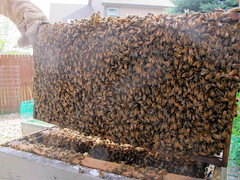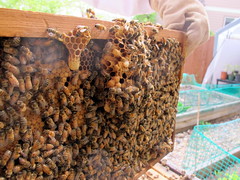During the inspection I'd done on the 19th, I had half a dozen BIG larvae out of their comb in the middle of the area between the two deep brood boxes. I was worried that I'd just killed a bunch of queen larvae, but they were all together. It turns out that if the hive is making queens, they usually spread them around the box, half a dozen of them. And the only way I could tell if they were really doing that was by doing in and looking through the whole top box, which is where most of the new eggs and larvae now are.
I had one objective on the 19th, which was to get the screened bottom board in and give the hive the ventilation it needed. On the 20th, I wanted to do a complete inspection of the top box, and get some powdered sugar into the hive for the mites. Plus, on the 19th, one of the frames in the top box had the bottom bar break free of the frame, so I needed to wire it together so that it wouldn't fall apart.
When I finally got around to getting the frame out, balance on the edge of the box, and a wire around it, I found that I couldn't manipulate the wire except by taking a glove off. It was just too thin a wire, and there were too many manipulations I had to do very carefully for me to be able to do it any way but barehanded.
I was shaking pretty badly with that, but none of the girls bothered my hand at all. There were four of them bumping constantly at my veil and buzzing me continuously, but none of them bothered my hand at all. I was pretty impressed. I did get the wire around the frame and twisted together to hold. I was amazed at how hard that actually turned out to be, but I think it'll be all right. The bees can't get rid of the wire the way they can bite and chew and remove rubber bands (it still amazes me how quick they are to do that).
But the old deep frame are definitely coming apart.
The entire hive was just dripping with bees. So many bees that I couldn't even see everything that the comb was holding, but this particular blanket of bees was pretty smooth. Queen cells are bumps that are on the edges, usually, and by themselves, whereas the regular worker brood is more like this, just covered with nurse bees and the foragers who are bringing in pollen and nectar to feed all the babies.
I was amazed. The upper box had been much lighter than the lower box, but then again the lower box was more full of honey. If the upper was nearly entirely full of brood, it would be lighter than the liquid content of the honey boxes and frames.
There were some lumps and bumps, and sections that the girls had built when and where the neighboring frame was bare.
It allowed them to build the drone comb, where the cells are MUCH bigger than the worker comb, and they fill them with the male drones. The drones are very large, and they grow in packs like the big lump there in the middle. One of the strange things was realizing that there were no queen cells but a whole lot of drone clumps in all the edges and nooks and crannies that I hadn't really been able to see that much of. One of the really big chunks was right where those other poor larvae had fallen out when I'd pulled apart the boxes.
So there were drones, but all good, healthy hives are going to throw off a lot of drones this time of year. It's a way of sharing the hive's genetics, and it's a natural part of the bounty of the nectar flow. The good news was that I didn't see any queen cells at all. And I was able to drop a lot more powdered sugar on everyone. *laughs*
One of the strangest "growths" was this one, which was at the bottom corner of one of the frames. The facing frame was completely bare. This was made even more strange with the powdered sugar which I put on before I took the picture, by accident. But the fall of sugar makes it even odder yet.
Still, it really look like drone comb to me, just big cells all together instead of single Queen cells. So it looks like the hive isn't going to be swarming soon, and I'm trying to stay ahead of it by adding supers and making the hive bigger all the time.
Tuesday, May 27, 2014
Monday, May 19, 2014
Just a bit of summer ventilation
I went in today to add the screened bottom board with sticky paper to see what the mite count is like. I wanted to get some powdered sugar in there as I could see that the girls were cleaning themselves off on the entrance board, and I also wanted to see how they were doing with the super. AND I didn't have my husband's usual help as he was busy all day.
So I got everything ready, suited up, got my weather cover off by hand, lit the smoker, and went in. It was relatively simple to just get the boxes off, moved onto surfaces that could catch a queen if she happened to drop, and I found drones everywhere. Tis the seasons for the boys to get out, I suppose, but they were so big and I haven't been good at spotting the queen and I was just wondering if any of them were her, especially once I got down to the bottom board, had all the workers who were trying to come in backed up and buzzing me, and one of the drones took off from the bottom board and dropped into one of my basement window wells. Agh.
Anyway... I also had problems remembering how everything went with the bottom board and the screened board. One of those utterly newbie mistakes where I just forgot how the damned thing went together, and spent five minutes trying to keep bees off all the pieces and puzzle-solve it while all the bees were gathering in a bigger and bigger cloud.
Of course I also found three huge larva, naked, between the bottom brood box and the top brood box. At first, I panicked, thinking that they were exposed queen larvae... and that the hive is thinking about swarming! Eeek... but they were all in a bunch and there wasn't protective walls around them. I suspect that they were actually just more drones.
They were also going through the queen excluder to the supers and building comb in the super I'd placed a month ago. The top brood chamber isn't completely full, either, and I started to do a frame by frame inspection of the top box, but one of the old frames fell apart on me, the bottom bar just pulled free, with the nail right through it. I'm probably going to have to wire that one back together again eventually.
I think I was a little unnerved by just how MANY bees there are this spring compared even to last summer. There are just so many more of them!
I finally just decided to put everything back together, with the extra ventilation shims at the top of the hive, and the extra height bars for the front entrance, so that they have a bigger landing pad. It's hard to balance those things with gloved hands, but it was pretty clear that they were trying pretty hard to sting me when I found one of the girls hanging by her stinger in my deerskin glove. She didn't get through, though, so I'm going to have to go get my bee venom shot in a week or two. *laughs*
My goals were to just give the whole hive more ventilation and put the screened board in, and do a powdered sugar sprinkle. I got the powdered sugar into the brood boxes and we'll see how that goes in a few days. They clean the sugar off themselves and in the process clean off the Varroa mites. I haven't seen evidence of any other problems, yet, and I'm hoping that that'll be enough for this summer at least.
I did what I intended, but the possibility of the colony actually swarming really threw me. I wasn't expecting that, and I know that a second year queen is always stronger than the first year she starts to lay. I had added the super to make sure they had room, and they haven't actually filled all of the top brood box yet, either, so... there may actually be plenty of space. It's all such a puzzle, and I need to keep ahead of them to accommodate their needs. I'd rather not split them unless I have to... which probably means I need to really go in and do another frame-by-frame check to see if there are queen cells anywhere.
Probably in the next day or two. Sadly, since John wasn't here, I wasn't able to get any pictures of anything, and it would have been really useful to have pictures of the broken open larvae for ID purposes from experienced keepers.
So I got everything ready, suited up, got my weather cover off by hand, lit the smoker, and went in. It was relatively simple to just get the boxes off, moved onto surfaces that could catch a queen if she happened to drop, and I found drones everywhere. Tis the seasons for the boys to get out, I suppose, but they were so big and I haven't been good at spotting the queen and I was just wondering if any of them were her, especially once I got down to the bottom board, had all the workers who were trying to come in backed up and buzzing me, and one of the drones took off from the bottom board and dropped into one of my basement window wells. Agh.
Anyway... I also had problems remembering how everything went with the bottom board and the screened board. One of those utterly newbie mistakes where I just forgot how the damned thing went together, and spent five minutes trying to keep bees off all the pieces and puzzle-solve it while all the bees were gathering in a bigger and bigger cloud.
Of course I also found three huge larva, naked, between the bottom brood box and the top brood box. At first, I panicked, thinking that they were exposed queen larvae... and that the hive is thinking about swarming! Eeek... but they were all in a bunch and there wasn't protective walls around them. I suspect that they were actually just more drones.
They were also going through the queen excluder to the supers and building comb in the super I'd placed a month ago. The top brood chamber isn't completely full, either, and I started to do a frame by frame inspection of the top box, but one of the old frames fell apart on me, the bottom bar just pulled free, with the nail right through it. I'm probably going to have to wire that one back together again eventually.
I think I was a little unnerved by just how MANY bees there are this spring compared even to last summer. There are just so many more of them!
I finally just decided to put everything back together, with the extra ventilation shims at the top of the hive, and the extra height bars for the front entrance, so that they have a bigger landing pad. It's hard to balance those things with gloved hands, but it was pretty clear that they were trying pretty hard to sting me when I found one of the girls hanging by her stinger in my deerskin glove. She didn't get through, though, so I'm going to have to go get my bee venom shot in a week or two. *laughs*
My goals were to just give the whole hive more ventilation and put the screened board in, and do a powdered sugar sprinkle. I got the powdered sugar into the brood boxes and we'll see how that goes in a few days. They clean the sugar off themselves and in the process clean off the Varroa mites. I haven't seen evidence of any other problems, yet, and I'm hoping that that'll be enough for this summer at least.
I did what I intended, but the possibility of the colony actually swarming really threw me. I wasn't expecting that, and I know that a second year queen is always stronger than the first year she starts to lay. I had added the super to make sure they had room, and they haven't actually filled all of the top brood box yet, either, so... there may actually be plenty of space. It's all such a puzzle, and I need to keep ahead of them to accommodate their needs. I'd rather not split them unless I have to... which probably means I need to really go in and do another frame-by-frame check to see if there are queen cells anywhere.
Probably in the next day or two. Sadly, since John wasn't here, I wasn't able to get any pictures of anything, and it would have been really useful to have pictures of the broken open larvae for ID purposes from experienced keepers.
Subscribe to:
Posts (Atom)



